Never miss another geomagnetic storm. Sign up for Space Weather Alerts and you'll receive a text message when magnetic storms erupt. Aurora your guides and professional astronomers use this service. You can, too! | | |
GEOMAGNETIC STORM: A co-rotating interaction region (CIR) hit Earth's magnetic field on July 7th, sparking a G1-class geomagnetic storm. The storm is subsiding now but it could flare up again if BsubZ continues to point south. High-latitude photographers should remain alert for auroras on the night of July 7-8. Aurora alerts: SMS Text.
BIG SUNSPOT: Big new sunspot AR3053 is growing and turning toward Earth. This movie from NASA's Solar Dynamics Observatory shows the latest 48 hours of development:

The sunspot now has not just one but two dark cores wider than Earth. These dimensions make it an easy target for backyard solar telescopes. If you don't have a solar telescope, try the projection method instead. It works with any telescope.
Realtime Space Weather Photo Gallery
Free: Spaceweather.com Newsletter
VERY BRIGHT NOCTILUCENT CLOUDS: On Wednesday morning, July 6th, sky watchers in Europe woke up to some of the brightest noctilucent clouds (NLCs) in years. "The clouds were amazingly bright and remained very evident deep into dawn," reports Daniel Fischer, who sends this picture from Bochum, Germany:
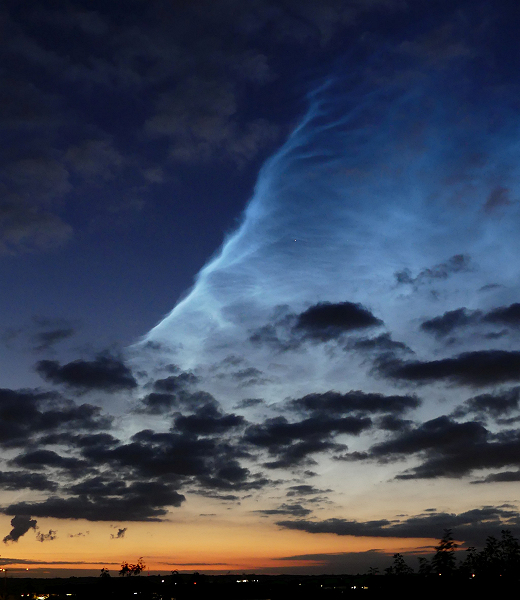
The clouds didn't stop there. They spread south across Europe, backlighting the Eiffel Tower and completely filling skies in places where, normally, NLCs are confined to a thin band near the horizon.
NLCs are Earth's highest clouds. Seeded by meteoroids, they float at the edge of space more than 80 km above the ground. NLCs form when summertime wisps of water vapor rise up to the mesosphere, allowing water to crystallize around specks of meteor smoke. They are a natural phenomenon.
Early July is usually a good time to see NLCs in the northern hemisphere, but this July is exceptional. Looking down on Earth's north pole, NASA's AIM spacecraft is seeing some of the strongest NLC activity in 15 years:

These plots display the frequency (abundance) of NLCs at two northern latitudes: 69o and 80o. Red is 2022; gray traces 14 previous seasons.
"This season appears to be a strong one throughout the polar region," says Cora Randall, a professor at the University of Colorado Boulder. "In fact, although day-to-day variability is substantial, on July 2nd AIM measured higher cloud frequencies at 69N latitude than in any other year since the spacecraft was launched."
Water vapor from rocket exhaust may be boosting the clouds to near-record levels. The spike in the 69o plot, in particular, is suspected to be a result of SpaceX's launch of the Globalstar satellite on June 19th. It is well known that the pace of rocket launches has been increasing. In the month of June 2022 alone there were 16 launches that added water to the upper atmosphere. The link between rockets and NLCs is an area of active research.
As July unfolds, NLCs have spilled far beyond the poles. This week's sightings in Paris confirm that they are well into the mid-latitudes. Look for the clouds, ripply and electric-blue, just after sunset.
more images: from Bertrand Kulik of Paris, France; from Laura Kranich of Kiel, Schleswig-Holstein, Germany; from Graham Wheatley of Portsmouth, England; from Jacob Kuiper of Steenwijk, The Netherlands; from Peter Paul Hattinga Verschure of Deventer, The Netherlands; from Ian Carstairs of Harleston, Norfolk,UK
Realtime Noctilucent Cloud Photo Gallery
Free: Spaceweather.com Newsletter
THE EDGE OF SPACE BUTTERFLY: Are you looking for a far-out gift? Consider the Edge of Space Butterfly. On June 26, 2022, this crystal pendant hitched a ride onboard an Earth to Sky Calculus cosmic ray research balloon:
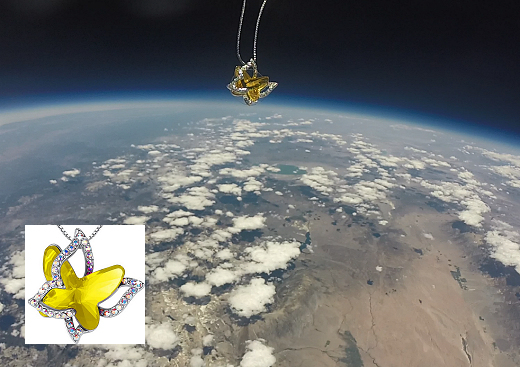
You can have it for $162.95. The inner yellow citrine crystal is surrounded by a "spread your wings" lattice of sparkling zirconia. A rich layer of rhodium plating ensures the longevity of the pendant and its 18-inch chain.
The Edge of Space Butterfly makes a great anniversary, Christmas, or birthday gift. It comes with a greeting card showing the pendant in flight and telling the story of its trip to the stratosphere and back again.
Far Out Gifts: Earth to Sky Store
All sales support hands-on STEM education
Realtime Aurora Photo Gallery
Free: Spaceweather.com Newsletter
Every night, a network of
NASA all-sky cameras scans the skies above the United States for meteoritic fireballs. Automated software maintained by NASA's Meteoroid Environment Office calculates their orbits, velocity, penetration depth in Earth's atmosphere and many other characteristics. Daily results are presented here on Spaceweather.com.
On July 07, 2022, the network reported 8 fireballs.
(8 sporadics)
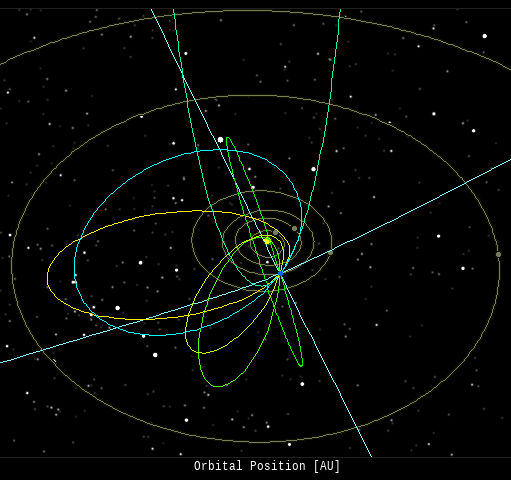
In this diagram of the inner solar system, all of the fireball orbits intersect at a single point--Earth. The orbits are color-coded by velocity, from slow (red) to fast (blue). [Larger image] [movies]
Potentially Hazardous Asteroids (
PHAs) are space rocks larger than approximately 100m that can come closer to Earth than 0.05 AU. None of the known PHAs is on a collision course with our planet, although astronomers are finding
new ones all the time.
On July 7, 2022 there were 2279 potentially hazardous asteroids.
 |
Recent & Upcoming Earth-asteroid encounters: | Asteroid | Date(UT) | Miss Distance | Velocity (km/s) | Diameter (m) |
| 2022 MF | 2022-Jul-02 | 14.8 LD | 12.1 | 43 |
| 2022 NK | 2022-Jul-02 | 0.8 LD | 12.4 | 13 |
| 2022 MB1 | 2022-Jul-02 | 19.1 LD | 6.3 | 17 |
| 2022 JE1 | 2022-Jul-03 | 8.6 LD | 5.6 | 74 |
| 2022 NP | 2022-Jul-04 | 19.7 LD | 13.9 | 34 |
| 2022 MY | 2022-Jul-05 | 13 LD | 7.2 | 27 |
| 2021 EL4 | 2022-Jul-05 | 19.9 LD | 9.5 | 25 |
| 2022 NO | 2022-Jul-06 | 13.2 LD | 10.9 | 31 |
| 2022 NE | 2022-Jul-06 | 0.4 LD | 10.7 | 7 |
| 2022 NQ | 2022-Jul-07 | 15.6 LD | 8.5 | 25 |
| 2022 NF | 2022-Jul-07 | 0.2 LD | 11.4 | 7 |
| 2022 NR | 2022-Jul-10 | 1 LD | 8.3 | 27 |
| 2022 NS | 2022-Jul-10 | 3.3 LD | 11.9 | 15 |
| 2019 NW5 | 2022-Jul-10 | 14.9 LD | 16 | 62 |
| 2022 NH | 2022-Jul-11 | 3.9 LD | 10.1 | 21 |
| 2015 OQ21 | 2022-Jul-12 | 18.3 LD | 6.6 | 9 |
| 2022 NC | 2022-Jul-14 | 7.6 LD | 7.5 | 33 |
| 2022 NJ | 2022-Jul-15 | 3.4 LD | 8.9 | 25 |
| 2022 LR1 | 2022-Jul-16 | 9.3 LD | 4.7 | 42 |
| 2022 KY4 | 2022-Jul-17 | 15.9 LD | 7.6 | 91 |
| 2021 OT | 2022-Jul-17 | 16.5 LD | 11.2 | 20 |
| 349068 | 2022-Jul-19 | 17.6 LD | 22.9 | 756 |
| 2017 RX2 | 2022-Jul-24 | 17.2 LD | 14.2 | 17 |
| 2022 ML3 | 2022-Jul-26 | 7.6 LD | 1.5 | 13 |
| 2016 CZ31 | 2022-Jul-29 | 7 LD | 15.6 | 129 |
| 531944 | 2022-Jul-30 | 18.2 LD | 5.9 | 192 |
| 2020 PP1 | 2022-Aug-01 | 13.1 LD | 3.7 | 17 |
| 2020 PN1 | 2022-Aug-03 | 9.7 LD | 4.6 | 29 |
| 2015 FF | 2022-Aug-12 | 11.2 LD | 9.2 | 17 |
| 2019 AV13 | 2022-Aug-22 | 19.1 LD | 8.8 | 135 |
| 2020 QW3 | 2022-Aug-22 | 14.1 LD | 18.1 | 30 |
| 2015 QH3 | 2022-Aug-22 | 5.6 LD | 7 | 14 |
| 2017 BU | 2022-Aug-29 | 15.8 LD | 7 | 32 |
| 2021 CQ5 | 2022-Sep-01 | 8.7 LD | 13.5 | 7 |
Notes: LD means "Lunar Distance." 1 LD = 384,401 km, the distance between Earth and the Moon. 1 LD also equals 0.00256 AU. MAG is the visual magnitude of the asteroid on the date of closest approach. | | Cosmic Rays in the Atmosphere |
SPACE WEATHER BALLOON DATA: Almost once a week, Spaceweather.com and the students of Earth to Sky Calculus fly space weather balloons to the stratosphere over California. These balloons are equipped with sensors that detect secondary cosmic rays, a form of radiation from space that can penetrate all the way down to Earth's surface. Our monitoring program has been underway without interruption for 7 years, resulting in a unique dataset of in situ atmospheric measurements.
Latest results (Nov. 2021): Our balloons have just measured a sudden drop in atmospheric radiation. It happened during the strong geomagnetic storms of Nov. 3-4, 2021. Here are the data:
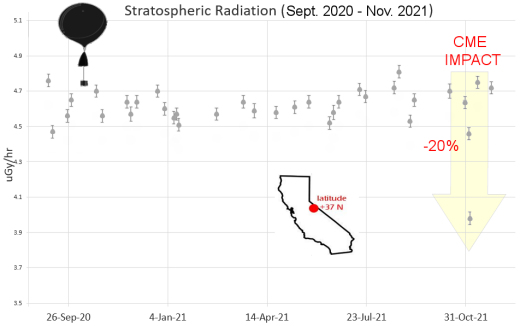
This is called a "Forbush decrease," named after American physicist Scott Forbush who studied cosmic rays in the early 20th century. It happens when a CME from the sun sweeps past Earth and literally pushes cosmic rays away from our planet. Radiation from deep space that would normally pepper Earth's upper atmosphere is briefly wiped out.
We have measured Forbush decreases before. For example, here's one from Sept. 2014. The Forbush Decrease of Nov. 3-4, 2021, was the deepest in the history of our 7-year atmospheric monitoring program. Radiation levels in the stratosphere over California dropped nearly 20%, more than doubling the previous record from our dataset.
En route to the stratosphere, our sensors also pass through aviation altitudes, so we can sample radiation where planes fly. This plot shows how the Forbush decrease was restricted to the stratosphere; it did not affect lower levels of the atmosphere:
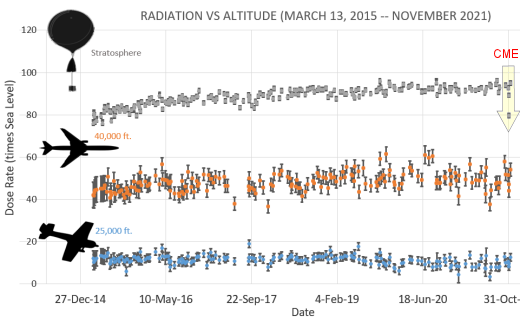
The dose rates shown above are expressed as multiples of sea level. For instance, we see that boarding a plane that flies at 25,000 feet exposes passengers to dose rates ~10x higher than sea level. At 40,000 feet, the multiplier is closer to 50x. The higher you fly, the more radiation you will absorb.
.Who cares? Cosmic rays are a surprisingly "down to Earth" form of space weather. They can seed clouds, trigger lightning, and penetrate commercial airplanes. According to a study from the Harvard T.H. Chan school of public health, crews of aircraft have higher rates of cancer than the general population. The researchers listed cosmic rays, irregular sleep habits, and chemical contaminants as leading risk factors. Somewhat more controversial studies (#1, #2, #3, #4) link cosmic rays with cardiac arrhythmias and sudden cardiac death.
.Technical notes: The radiation sensors onboard our helium balloons detect X-rays and gamma-rays in the energy range 10 keV to 20 MeV. These energies span the range of medical X-ray machines and airport security scanners.
Data points in the first graph ("Stratospheric Radiation") correspond to the peak of the Regener-Pfotzer maximum, which lies about 67,000 feet above central California. When cosmic rays crash into Earth's atmosphere, they produce a spray of secondary particles that is most intense at the entrance to the stratosphere. Physicists Eric Regener and Georg Pfotzer discovered the maximum using balloons in the 1930s and it is what we are measuring today.
| | The official U.S. government space weather bureau |
| | The first place to look for information about sundogs, pillars, rainbows and related phenomena. |
| | Researchers call it a "Hubble for the sun." SDO is the most advanced solar observatory ever. |
| | 3D views of the sun from NASA's Solar and Terrestrial Relations Observatory |
| | Realtime and archival images of the Sun from SOHO. |
| | information about sunspots based on the latest NOAA/USAF Active Region Summary |
| | from the NOAA Space Environment Center |
| | fun to read, but should be taken with a grain of salt! Forecasts looking ahead more than a few days are often wrong. |
| | from the NOAA Space Environment Center |
| | the underlying science of space weather |
 | BestCSGOGambling is the best site for everything related to CSGO gambling on the web |
 | To find reviews of new online casino sites in the UK try The Casino DB where there are hundreds of online casino reviews complete with bonuses and ratings. Alternatively, Online-Casinos.xyz is another massive directory of online casinos listing sites for the UK and Worldwide. Casinos that offer Rupees for bonuses are very generous to Indian players. Find the best online casinos in India at AllCasinos.in Looking for a new online casino? Try Casimpo the new site dedicated to making online casino simple, or check out the new Avenger Slots Casino and Ace Online Casino with over 500 online slots and casino games. |
 | One of the most popular casino games is the Book Of Dead Slot based on ancient Egyptian text, you can find all the casinos with spins at bookofdeadslotsites.com. |
 | When looking for casinos to play online when the weather is bad, you can try casino online trucchi for Italian games. If you are not from Finland you can try the Swedish page Svenska casino online to find suitable games, check out svenskacasinoonline.net. Always check your local laws before playing with real money. |
 | Looking for sports betting companies not registered on GamStop? CasinoGap has presented a list of sites not on GamStop available for UK players. Check and bet online! Would you like to bet at sites not using GamStop? Look at a list of NonStopCasino sites for online betting that aren't on GamStop. Top-rated bookmakers ever! |
| | These links help Spaceweather.com stay online. Thank you to our supporters! |
| | | | | | |

